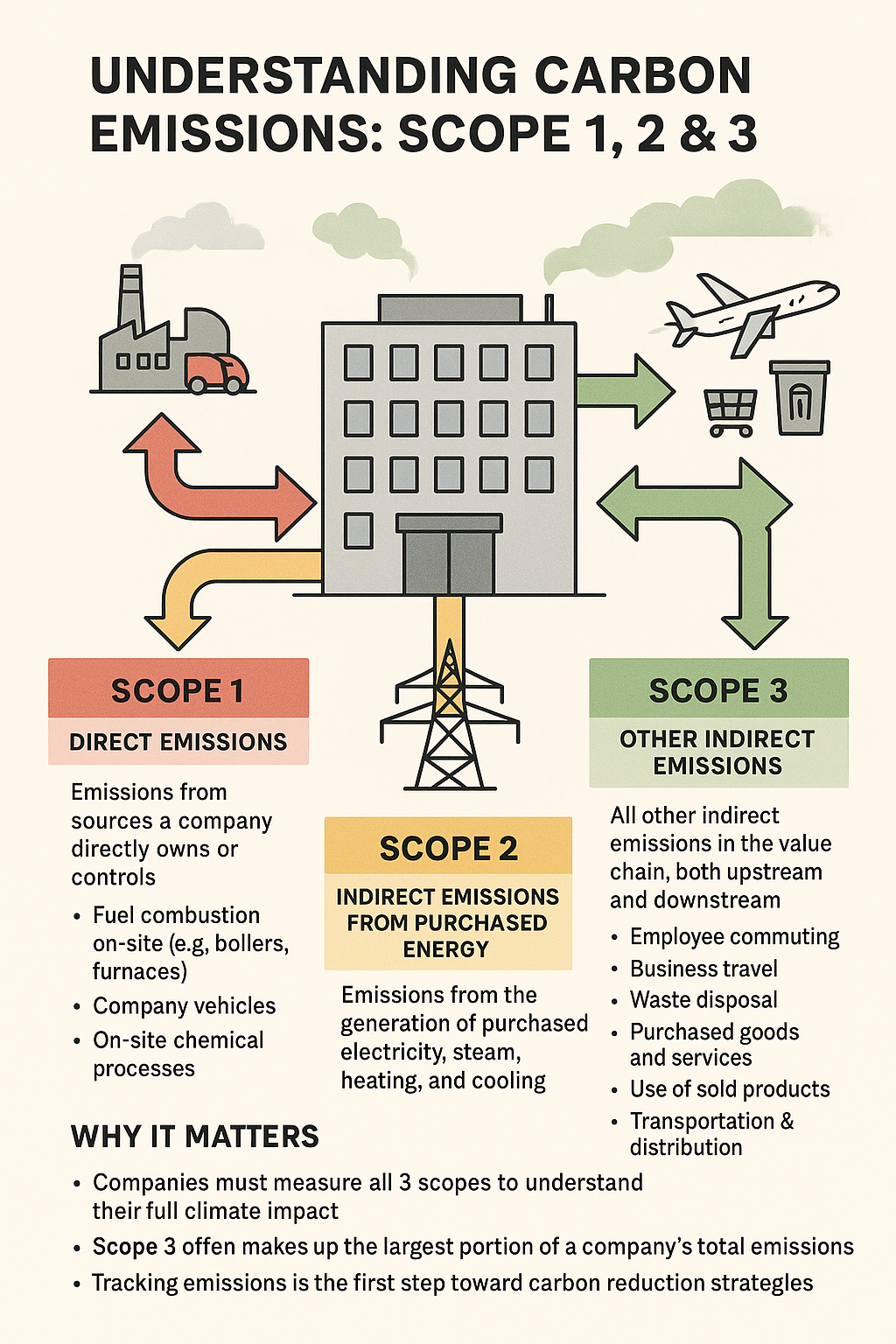As businesses strive to minimise their environmental impact, understanding and managing Scope 3 emissions has become crucial.
At Unisort, our mission is to make workplace recycling easier, engaging, and efficient, which is why we have put together this guide to demystify Scope 3 emissions and illustrate how recycling can play a pivotal role in reducing your company’s carbon footprint.
Understanding Scope 3 Emissions
Scope 3 emissions are indirect greenhouse gas emissions that occur in a company’s value chain but are not owned or directly controlled by the company.
There are a total of 15 Scope 3 emissions sources under the Greenhouse Gas Protocol, which is the internationally recognised standard for carbon foot printing.
These emissions can arise from both upstream and downstream activities, including:
-
Purchased goods and services
-
Business travel
-
Employee commuting
-
Waste generated in operations
-
Use of sold products
-
End-of-life treatment of sold products
Unlike Scope 1 (direct emissions from owned or controlled sources) and Scope 2 (indirect emissions from the generation of purchased electricity, heating, steam, and cooling), Scope 3 emissions encompass a broader range of activities and are often the most complex to measure and manage.
For many organisations, Scope 3 emissions represent over 70% of their total carbon footprint, underscoring the importance of addressing them in sustainability strategies.
Why Do You Need to Consider Scope 3 Emissions?
Most businesses traditionally report on Scopes 1 and 2 emissions, as these are directly controllable and measurable using readily available data. Focusing on these scopes gives a good initial overview of a company’s direct climate impact. However, Scope 3 emissions, which cover the entire value chain, present a more complex challenge.
Without achieving Scope 3 a business will not achieve net zero.
Despite the complexity, addressing Scope 3 is crucial for reduction goals as it often surpasses the impact of Scopes 1 and 2 combined. Understanding Scope 3 emissions provides deeper insights into a company’s activities, helping to identify business practices that negatively impact the environment.
By addressing Scope 3 emissions, businesses can achieve a comprehensive understanding of their carbon footprint and identify significant opportunities for reduction.
The Role of Recycling in Reducing Scope 3 Emissions
Recycling can be a powerful tool in your company’s fight against climate change, offering substantial benefits for reducing Scope 3 emissions. Whilst the more complex nature of Scope 3 emissions may seem daunting, efficient recycling systems can have a bigger impact than you may realise.
Among the various sources of Scope 3 emissions, waste disposal and treatment play a significant role.
Here are just some of the ways recycling can help:
Reducing Harmful Emissions from Waste Disposal: One of the primary sources of Scope 3 emissions is waste generated in operations.
This includes all solid and liquid waste produced by an organisation’s daily activities, from packaging materials and food scraps to outdated electronics and office paper.
Once this waste leaves the premises, its environmental impact depends heavily on the disposal method:
- Landfilling leads to methane release, a greenhouse gas more than 25 times more potent than CO₂.
- Incineration produces CO₂ and other pollutants, although it may recover some energy.
- Recycling, however, generally has a much lower carbon footprint, especially when it displaces the need for virgin materials.
By implementing effective recycling programmes, businesses can significantly reduce the volume of waste sent to landfill or incineration, thereby lowering their associated emissions.
Encouraging Sustainable Procurement: When businesses prioritise recycled materials in their procurement processes, they support markets for recycled goods, encouraging more sustainable production practices upstream in the value chain.
This supports more sustainable production practices upstream in the value chain and contributes to a circular economy, reducing Scope 3 emissions from purchased goods and services.
Minimising the Need for New Materials: Recycling helps conserve natural resources and significantly reduces energy demand. For example:
- Producing recycled aluminium uses 95% less energy than creating it from virgin ore.
- Recycling paper reduces the need for deforestation and associated emissions.
By reducing the demand for new raw materials, companies lower emissions related to extraction, manufacturing, and transportation.
Engaging Employees and Promoting a Sustainable Culture: Implementing workplace recycling programmes can engage employees and foster a culture of sustainability.
This not only helps reduce emissions from waste but also encourages employees to adopt more sustainable practices in their personal lives, such as lift sharing or walking to work.
This can lead to wider benefits such as:
- Reduced waste contamination through better sorting.
- Increased participation in workplace sustainability initiatives.
- More sustainable commuting choices, such as lift sharing, cycling, or walking to work.
Practical Steps to Improve Recycling at Work
Organisations looking to reduce Scope 3 emissions through better waste management can start with these steps:
-
Audit Waste Streams: Identify what types of waste are being produced and in what quantities. Also check the contamination rate and ask why this is happening. Then establish what percentage of overall waste volume is being recycled.
-
Set Clear Recycling Policies: Provide labelled recycling stations for paper, plastics, metals/tins, food & liquid waste and general waste.
-
Engage Employees: Offer training and awareness campaigns to encourage proper recycling behaviour.
-
Work with Waste Management Partners: Choose vendors that prioritise recycling and provide data on waste diversion rates.
-
Measure and Report: Track waste diversion and its impact on emissions and include these metrics in sustainability reports.
Diving Deeper Into Scope 1, 2, and 3 Carbon Emissions
Scope 1: Direct Emissions
These are greenhouse gas (GHG) emissions that a company produces directly. Examples include:
- Fuel combustion from company vehicles
- On-site energy production (e.g. burning natural gas)
- Emissions from owned or controlled equipment and facilities
How to Reduce Scope 1 Emissions:
- Switch to electric or hybrid vehicles
- Improve energy efficiency in operations
- Transition from fossil fuels to renewable energy sources on-site
- Maintain and optimise equipment to reduce leaks and emissions
Scope 2: Indirect Emissions from Purchased Energy
These are emissions from the generation of purchased electricity, steam, heating, and cooling used by the company.
How to Reduce Scope 2 Emissions:
- Purchase renewable energy (e.g. via green tariffs or Renewable Energy Certificates)
- Install on-site renewable energy (e.g. solar panels)
- Improve energy efficiency across buildings and processes
- Engage in demand response programmes to reduce peak energy use
Scope 3: Indirect Emissions Across the Value Chain
These are all other indirect emissions outside the company’s direct control, both upstream and downstream. Examples include:
- Emissions from suppliers and raw material extraction
- Transportation and distribution
- Use of sold products
- Employee commuting and business travel
- Waste disposal
How to Reduce Scope 3 Emissions:
- Work with suppliers to lower their carbon footprint
- Redesign products for energy efficiency and sustainability
- Encourage remote work and low-carbon commuting
- Use low-emission logistics partners
- Promote recycling and circular economy practices
Taking Action
Reducing Scope 3 emissions requires a deliberate effort across the entire business. While recycling plays a key role, real progress comes from addressing emissions holistically across all scopes. This means committing to:
- Data collection and transparency
- Collaboration with suppliers and stakeholders
- Investment in clean technology and renewable energy
- Integrating sustainability into your core business strategy
By understanding the sources of emissions and targeting each scope strategically, companies can make meaningful progress toward climate goals and demonstrate true environmental leadership.
At Unisort, we are dedicated to supporting your journey towards a more sustainable future. As a key part of any sustainability strategy, we believe that recycling should be easy, engaging, efficient, and eco-friendly. Our comprehensive recycling solutions are designed to empower businesses and their employees to recycle more effectively, lessening their impact on the environment.
For advice on how recycling solutions can help your business reduce its carbon footprint, contact our team of experts today.
Together, we can make a meaningful impact on the environment and take significant steps to reduce Scope 3 emissions.






